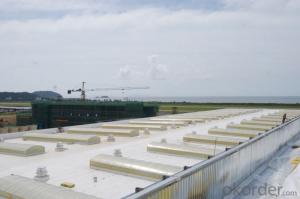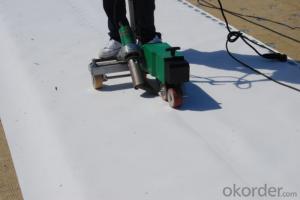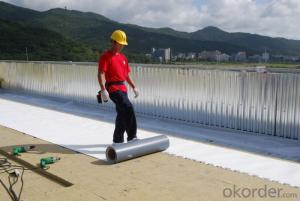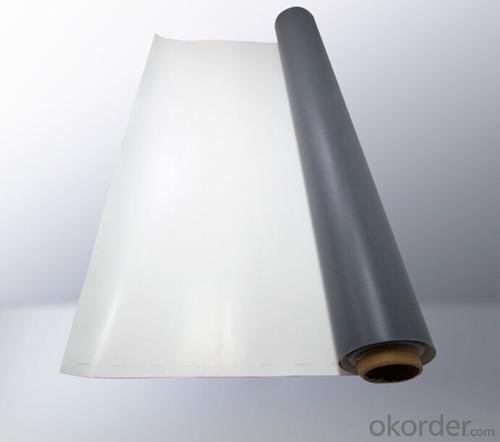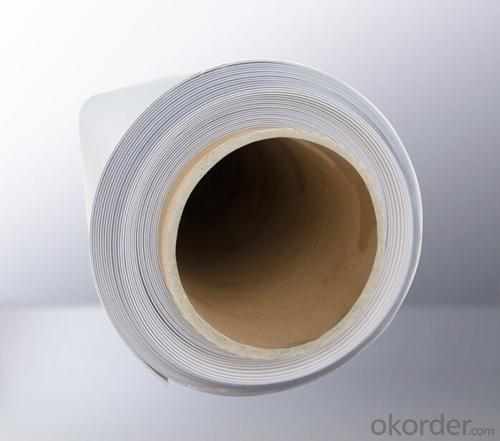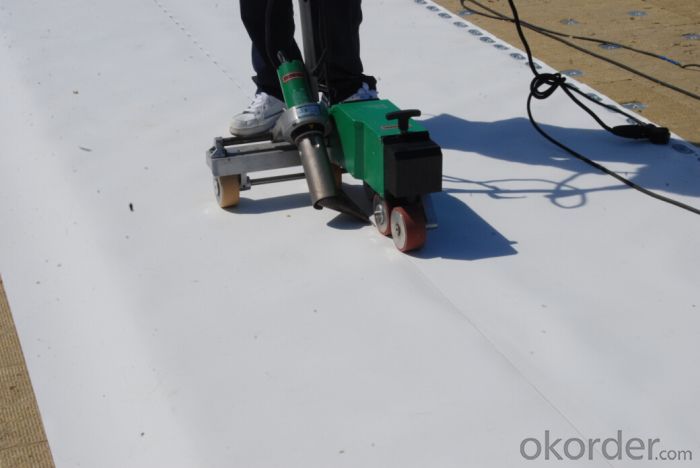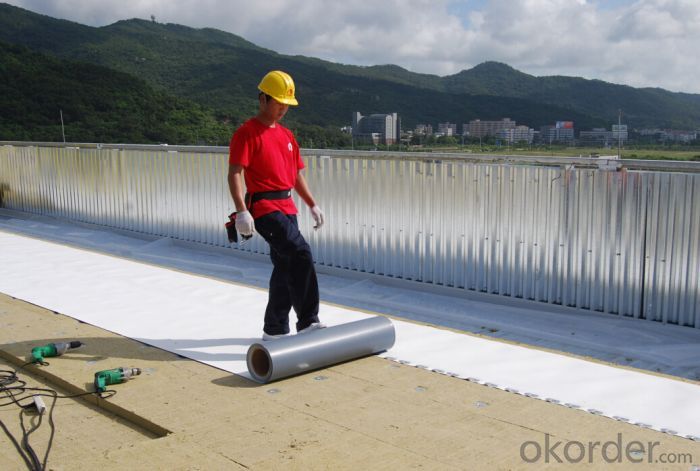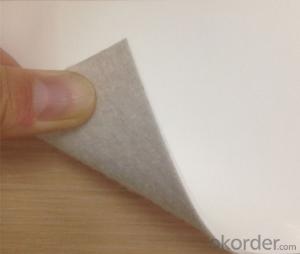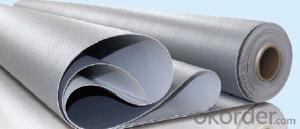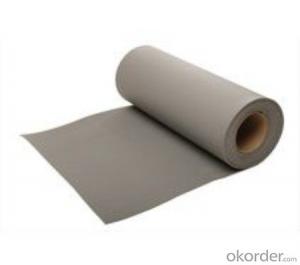(TPO) Polyester Fleece Backing Thermoplastic Polyolefin Waterproof Membrane
- Loading Port:
- Tianjin
- Payment Terms:
- TT or LC
- Min Order Qty:
- 5000 m²
- Supply Capability:
- 100000 m²/month
OKorder Service Pledge
OKorder Financial Service
You Might Also Like
Polyester Fleece Backing Thermoplastic Polyolefin Waterproof Membrane
TPO is a waterproofing sheet, consisting of thermoplastic polyolefin
Compound resin materials as the base stock, reinforced with polyester mesh fabric.
Product Applications:
Widely used in all kinds of building roof(exposed roof,planting roof,driving roof,light steel roof) and basement,tunnel,grain depot,subway,reservoir,etc.
Product Advantages:
1. Weather resistance and durability; Excellent weld ability;
2. No any crisp agents to prevent materials brittleness;
3. Intermediate enhanced polyester mesh fabric to have high tensile strength, fatigue resistance and penetrating resistance suitable for mechanically attached roofing systems;
4. Excellent the same high and low temperature resistance as rubber materials which can keep flexible at -50° C and keep mechanical strength in high temperature;
5. Excellent chemical resistance to acids, bases, and restaurant exhaust emissions; Dimension stability;
6. White-based light-color and smooth surface with high reflection, energy saving and anti-dust functions;
7. Use heat welding for the seam areas to form a reliable seamless waterproof layer.
Product Specifications:
Item | Requirement | Test Method | ||
Thickness, min, mm | Sheet-overall | ≥1.0 | ASTM D6878 | |
Coating over fabric or scrim, weathering side only | ≥0.305 | ASTM D751 | ||
Breaking strength, min, N | ≥976 | ASTM D751 | ||
Elongation at reinforcement break, min, % | ≥15 | ASTM D751 | ||
Tearing strength,min, N | ≥245 | ASTM D751 | ||
Brittleness point, max, °C | ≤-40 | ASTM D2137 | ||
Ozone resistance | no cracks | ASTM D1149 | ||
Properties after heat aging | Breaking strength, % min | ≥90 | ASTM D573 | |
Elongation at reinforcement break, % min | ≥90 | ASTM D573 | ||
Tearing strength, % min | ≥60 | ASTM D573 | ||
Weight change (mass), max % | ≤±1 | ASTM D573 | ||
Linear dimensional change, max, % | ≤±1 | ASTM D1204 | ||
Water absorption, max, mass % | ≤±3.0 | ASTM D471 | ||
Factory seam strength, min, N | ≥290 | ASTM D751 | ||
Weather resistance | Visual inspection | - | ||
FAQ:
Q: Can I get samples from your company?
A: Yes, we could offer free samples if you requirement.
Q: Can I do the third party testing before loading?
A: Yes, we could accept the third party testing.




- Q: The shortcomings of polypropylene waterproofing, and the shortcomings of modified asphalt waterproofing membrane
- Waterproofing membrane in the waterproof construction in accordance with the shape of the waterproof base of the bulk of the truncated, for the complex shape of the grassroots need to multi-block splicing, waterproofing membrane overlap at each other more difficult, due to the impact of multi-block splicing waterproof Layer of beauty; then completely completely sealed will become the main problem, the biggest hidden dangers, the most opportunities is the coiled parts of the coil; then high-grade waterproofing membrane with decades of durable durability,
- Q: Can a waterproofing membrane be used for temporary structures or tents?
- Indeed, temporary structures or tents can benefit from the utilization of a waterproofing membrane. These membranes are specifically crafted to create a safeguarding shield against water, thwarting any potential harm caused by water infiltration. Consequently, they prove to be an excellent selection for temporary structures or tents, ensuring that the interior remains dry in inclement weather or damp environments. Furthermore, the lightweight and pliable nature of waterproofing membranes simplifies their installation and removal, which is particularly advantageous for temporary structures or tents that necessitate relocation or disassembly.
- Q: 1.2 thick synthetic polymer waterproofing membrane two weight how to count
- Polymer waterproofing membrane is generally 1100 ~ 1400kg / m3, 1.0mm thick per square meter weight of about 1.1 ~ 1.4kg / m2, 1.2mm thick coil weight of about 1.3 ~ 1.7kg / m2, plus lap 10% , 1.2mm waterproof layer of the weight of 1.45 ~ 1.85kg / m2, if the adhesive paste, plus adhesive weight 0.2 ~ 0.4kg / m2, the total weight of about 1.7 ~ 2.3kg / m2, two about 3.4 ~ 4.6 Kg / m2.
- Q: Can a waterproofing membrane be used for sealing pipe penetrations?
- Sealing pipe penetrations can be achieved with the use of a waterproofing membrane. These membranes are specifically designed to form a barrier against water intrusion and can effectively seal different types of penetrations, including pipes. In construction projects, they are widely utilized to prevent water leaks and potential damage. By applying the waterproofing membrane around the pipe penetration, a watertight seal is created, preventing the entry or escape of water through the opening. This action helps maintain the building envelope's integrity and safeguards against potential water-related problems like leaks, mold growth, and structural damage. Moreover, waterproofing membranes often possess flexibility, enabling them to adapt to the shape and size of the pipe penetration, ensuring a secure and long-lasting seal.
- Q: Can a waterproofing membrane be used for crawl spaces or basements?
- A waterproofing membrane can be utilized for crawl spaces or basements. In truth, it is an extremely effective method for deterring water infiltration and moisture problems in these areas. Waterproofing membranes are designed to establish a protective barrier against water, stopping it from seeping into the crawl space or basement. They are typically composed of long-lasting materials like rubber, PVC, or polyethylene, which are resistant to water penetration. These membranes are then installed on the walls and floors of the crawl space or basement, forming a watertight seal. This helps to keep the area dry, prevent water damage, and decrease the likelihood of mold and mildew growth. Moreover, waterproofing membranes can also serve as a vapor barrier, preventing moisture from evaporating from the ground and entering the crawl space or basement. Overall, employing a waterproofing membrane is a recommended solution for maintaining a dry and healthy crawl space or basement.
- Q: Does a waterproofing membrane require any specific surface preparation for tile installations?
- Yes, a waterproofing membrane typically requires specific surface preparation for tile installations. The surface needs to be clean, dry, and free of any dirt, dust, or debris. It is important to remove any loose or damaged tiles, repair any cracks or imperfections, and ensure the surface is smooth and level before applying the waterproofing membrane. This preparation ensures proper adhesion and a successful tile installation.
- Q: Can a waterproofing membrane be applied to existing structures?
- Existing structures can have a waterproofing membrane applied to them. Applying a waterproofing membrane is a commonly used and effective method for preventing water infiltration and damage to buildings. Whether it's a concrete structure, roof, or basement, waterproofing membranes can be installed on the inside or outside surfaces to create a barrier against water penetration. There are various types of waterproofing membranes available, including liquid-applied, sheet, and spray-applied membranes, which can be chosen based on the specific needs of the structure. The process of applying a waterproofing membrane to an existing structure typically involves thorough surface preparation, such as cleaning, repairing any existing cracks or damages, and ensuring a smooth surface. Once the surface is prepared, the membrane is applied using the recommended method to ensure proper adhesion and coverage. Waterproofing membranes are designed to withstand environmental factors like UV rays, temperature changes, and water pressure, providing long-lasting protection for existing structures. However, it's important to consult a professional waterproofing contractor to assess the condition of the structure and determine the most suitable and effective waterproofing solution.
- Q: Can a waterproofing membrane be used for fire pit areas?
- Using a waterproofing membrane for fire pit areas is not recommended. Although waterproofing membranes are effective at preventing water penetration, they are not suitable for withstanding the intense temperatures and fire hazards typically found in fire pits. Specific fire-resistant materials are necessary for fire pit areas to withstand the heat and mitigate any potential fire accidents. To ensure safety and prevent damage, it is vital to use materials explicitly designed for fire pit areas.
- Q: Can a waterproofing membrane be used on asphalt surfaces?
- Yes, a waterproofing membrane can be used on asphalt surfaces. Waterproofing membranes are often used to protect various surfaces, including asphalt, from water damage. They create a barrier that prevents water from seeping into the asphalt, reducing the risk of cracks, deterioration, and other forms of damage caused by moisture.
- Q: Does a waterproofing membrane require a primer before application?
- In order to apply a waterproofing membrane, it is necessary to use a primer. The purpose of a primer is to improve the adhesion between the membrane and the substrate, guaranteeing a strong bond. Additionally, it acts as a sealant that protects the surface, preventing any moisture or impurities from affecting the efficiency of the waterproofing system. For a reliable and enduring waterproofing solution, it is crucial to apply a primer prior to the membrane.
Send your message to us
(TPO) Polyester Fleece Backing Thermoplastic Polyolefin Waterproof Membrane
- Loading Port:
- Tianjin
- Payment Terms:
- TT or LC
- Min Order Qty:
- 5000 m²
- Supply Capability:
- 100000 m²/month
OKorder Service Pledge
OKorder Financial Service
Similar products
Hot products
Hot Searches
Related keywords



